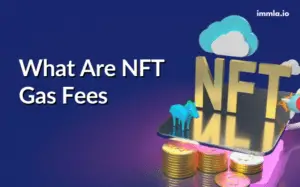While some NFTs are offered free by their creators, those who acquire them can sometimes have to pay a lot for them.
The main reason for this is the gas prices, which can sometimes rise astronomically.
For those new to the NFT space, it is important to understand gas fees and why they can be so high sometimes.
Gas Fee Explained
The gas fee is the fee charged by NFT trading platforms. This fee is incurred when conducting a transaction or executing a smart contract on the blockchain.
On Ethereum, the most popular NFT blockchain, gas fees are denoted as a Gwei unit.
Gas fees are determined by the traffic on the network and the computational power needed to execute a transaction.
The gas fees are used to pay those who maintain the security of the blockchain using powerful computational devices. It works similarly to how credit card transactions are processed.
When moving funds from one entity to another, there is a network behind them that has to be maintained.
These fees are used to ensure that those operations can continue to run.
A unit of gas is called a Gwei on Ethereum. To maintain its security, Ethereum uses a proof of work algorithm.
Those who maintain the network using the PoW algorithm are motivated to do so using the gas fees. Thus, the total transaction fee is equal to the gas limit x gas price at the moment of the transaction.
Everything on the Ethereum network costs some gas. Gas on the Ethereum network has been assigned a market price based upon the demand for resources in the network at a particular moment in time.
Why NFT Transaction Use Gas?
Gas ensures that users of the Ethereum blockchain are not spamming it. It is a simple solution to ensure the security of the network.
Gas fees are paid to the miners who maintain the network.
Understanding The Gas Limit
You can set the maximum amount of gas you wish to spend per transaction.
When you set the limit, you then have to wait until the network reaches your limit. This will help to ensure that you can have some control over how much transactions will cost.
Why Gas Fees Are A Challenge For Nft Artists
Gas fees are paid to create, buy, and sell an NFT.
However, this has proven to be a challenge for NFT artists. When gas prices rise, it becomes hard for an artist to create and sell a piece of NFT art.
When they try to set the limit for gas prices, the perceived value of the work of art diminishes.
Since the gas prices can differ from the actual value of the NFT, the costs may be higher than the price of the NFT.
Buyers also face a challenge with gas prices. Buyers have to pay gas prices when they place an order or decide to cancel it.
For new sellers, this can be a challenge since they may not be familiar with how gas prices work. Thus, they could risk losing a lot of money during transactions.
If they do not have enough funds to cover the gas fees, a transaction is reversed but they will still get charged.
How To Avoid High Gas Fees
While gas fees remain a challenge, there are a few ways to lower them, they include:
- Transact late at night or early in the morning when activity on the Ethereum blockchain is low
- Opt for other blockchains that support NFTs such as WAX, which do not require gas fees and transactions are near-instant
- Set a gas limit, which will ensure that your transaction is only processed at that limit
- Keep track of gas prices to have an estimate of how much you might end up paying
However, some of these tips will only work for transactions that are not time-sensitive.
Summary
As long as the challenge of gas prices remains, the full potential of NFTs may never be realized.
However, experts are working on the problems. One of the solutions is to move the Ethereum network from a PoW to a proof of stake algorithm.

